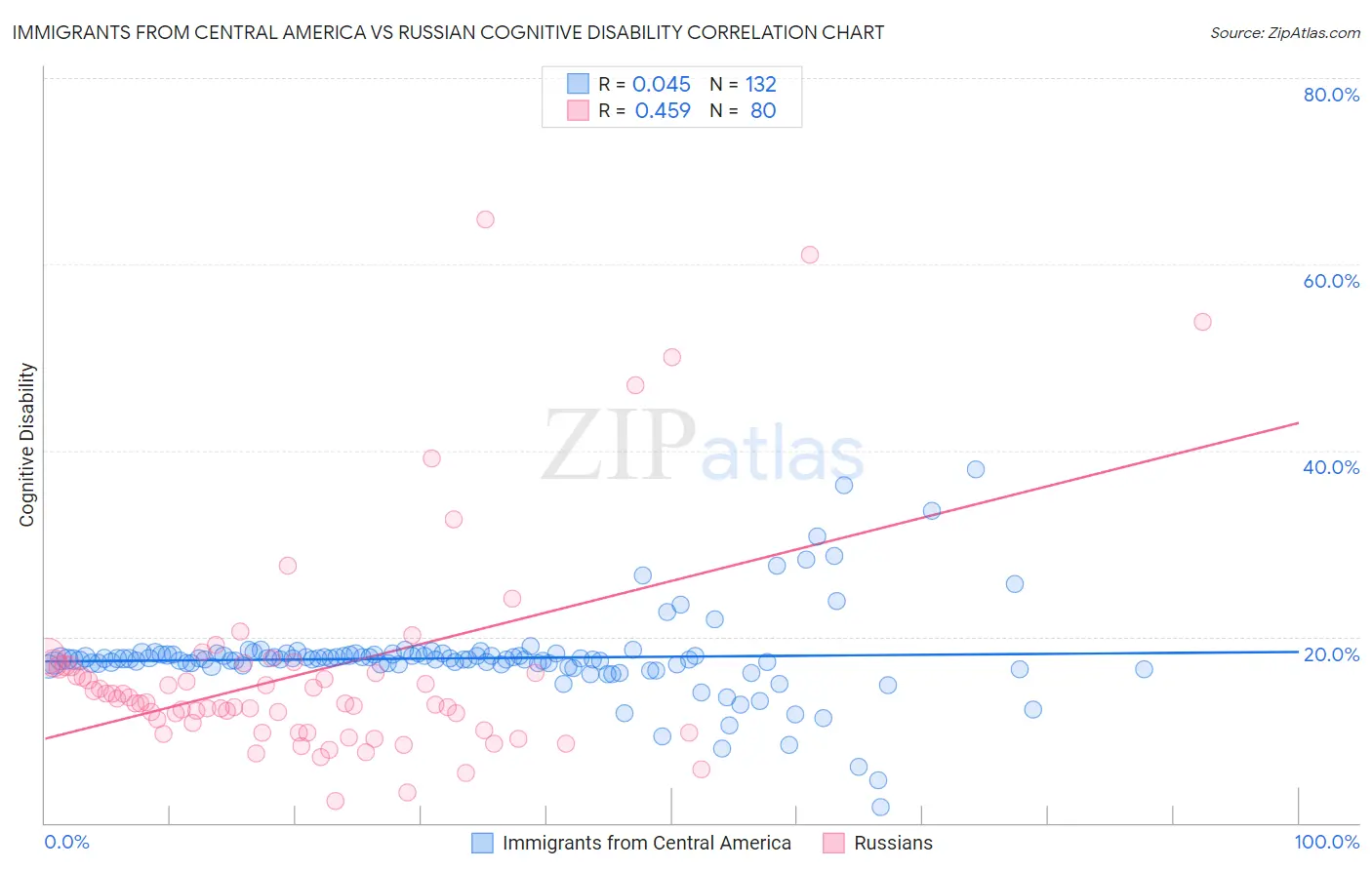Immigrants from Central America vs Russian Cognitive Disability
COMPARE
Immigrants from Central America
Russian
Cognitive Disability
Cognitive Disability Comparison
Immigrants from Central America
Russians
17.7%
COGNITIVE DISABILITY
2.3/ 100
METRIC RATING
228th/ 347
METRIC RANK
16.4%
COGNITIVE DISABILITY
99.9/ 100
METRIC RATING
34th/ 347
METRIC RANK
Immigrants from Central America vs Russian Cognitive Disability Correlation Chart
The statistical analysis conducted on geographies consisting of 536,382,294 people shows no correlation between the proportion of Immigrants from Central America and percentage of population with cognitive disability in the United States with a correlation coefficient (R) of 0.045 and weighted average of 17.7%. Similarly, the statistical analysis conducted on geographies consisting of 512,152,080 people shows a moderate positive correlation between the proportion of Russians and percentage of population with cognitive disability in the United States with a correlation coefficient (R) of 0.459 and weighted average of 16.4%, a difference of 8.1%.

Cognitive Disability Correlation Summary
| Measurement | Immigrants from Central America | Russian |
| Minimum | 1.8% | 2.3% |
| Maximum | 37.9% | 64.9% |
| Range | 36.2% | 62.5% |
| Mean | 17.7% | 16.1% |
| Median | 17.6% | 12.9% |
| Interquartile 25% (IQ1) | 17.0% | 9.9% |
| Interquartile 75% (IQ3) | 18.1% | 16.8% |
| Interquartile Range (IQR) | 1.1% | 7.0% |
| Standard Deviation (Sample) | 4.7% | 11.7% |
| Standard Deviation (Population) | 4.7% | 11.6% |
Similar Demographics by Cognitive Disability
Demographics Similar to Immigrants from Central America by Cognitive Disability
In terms of cognitive disability, the demographic groups most similar to Immigrants from Central America are Immigrants from Guatemala (17.7%, a difference of 0.020%), Mongolian (17.7%, a difference of 0.050%), Immigrants from St. Vincent and the Grenadines (17.7%, a difference of 0.080%), Guatemalan (17.8%, a difference of 0.080%), and Tongan (17.8%, a difference of 0.080%).
| Demographics | Rating | Rank | Cognitive Disability |
| Moroccans | 5.9 /100 | #221 | Tragic 17.6% |
| Central Americans | 4.5 /100 | #222 | Tragic 17.7% |
| Alsatians | 4.5 /100 | #223 | Tragic 17.7% |
| Fijians | 3.4 /100 | #224 | Tragic 17.7% |
| Vietnamese | 3.4 /100 | #225 | Tragic 17.7% |
| Marshallese | 2.7 /100 | #226 | Tragic 17.7% |
| Immigrants | St. Vincent and the Grenadines | 2.6 /100 | #227 | Tragic 17.7% |
| Immigrants | Central America | 2.3 /100 | #228 | Tragic 17.7% |
| Immigrants | Guatemala | 2.2 /100 | #229 | Tragic 17.7% |
| Mongolians | 2.2 /100 | #230 | Tragic 17.7% |
| Guatemalans | 2.1 /100 | #231 | Tragic 17.8% |
| Tongans | 2.1 /100 | #232 | Tragic 17.8% |
| Panamanians | 2.1 /100 | #233 | Tragic 17.8% |
| Osage | 2.0 /100 | #234 | Tragic 17.8% |
| Spanish American Indians | 2.0 /100 | #235 | Tragic 17.8% |
Demographics Similar to Russians by Cognitive Disability
In terms of cognitive disability, the demographic groups most similar to Russians are Italian (16.4%, a difference of 0.0%), Immigrants from Israel (16.4%, a difference of 0.080%), Slovak (16.4%, a difference of 0.080%), Greek (16.4%, a difference of 0.090%), and Immigrants from Romania (16.4%, a difference of 0.13%).
| Demographics | Rating | Rank | Cognitive Disability |
| Immigrants | Pakistan | 99.9 /100 | #27 | Exceptional 16.4% |
| Poles | 99.9 /100 | #28 | Exceptional 16.4% |
| Filipinos | 99.9 /100 | #29 | Exceptional 16.4% |
| Czechs | 99.9 /100 | #30 | Exceptional 16.4% |
| Immigrants | Romania | 99.9 /100 | #31 | Exceptional 16.4% |
| Immigrants | Israel | 99.9 /100 | #32 | Exceptional 16.4% |
| Italians | 99.9 /100 | #33 | Exceptional 16.4% |
| Russians | 99.9 /100 | #34 | Exceptional 16.4% |
| Slovaks | 99.9 /100 | #35 | Exceptional 16.4% |
| Greeks | 99.9 /100 | #36 | Exceptional 16.4% |
| Slovenes | 99.9 /100 | #37 | Exceptional 16.5% |
| Immigrants | Eastern Europe | 99.9 /100 | #38 | Exceptional 16.5% |
| Bolivians | 99.9 /100 | #39 | Exceptional 16.5% |
| Immigrants | Belarus | 99.9 /100 | #40 | Exceptional 16.5% |
| Cubans | 99.9 /100 | #41 | Exceptional 16.5% |